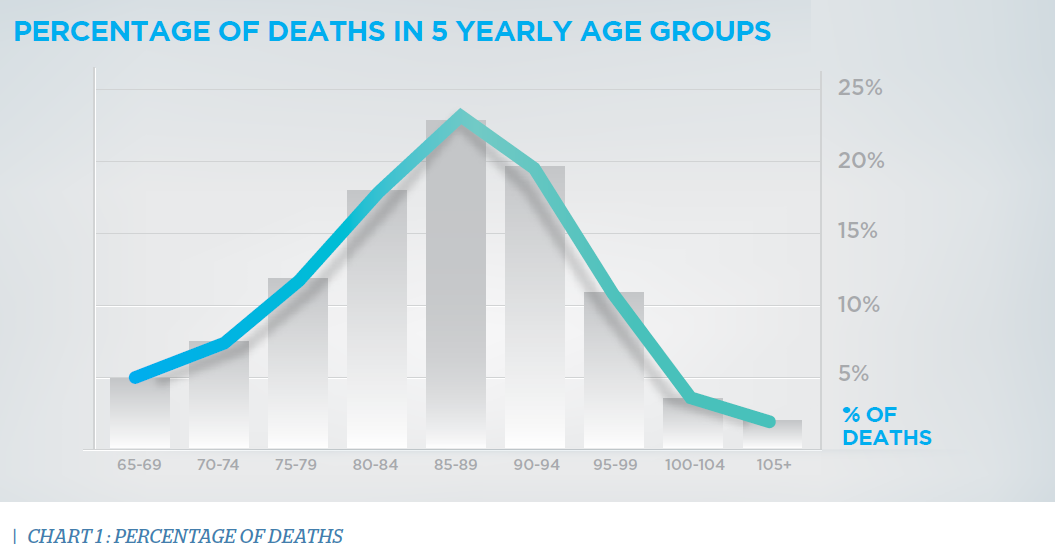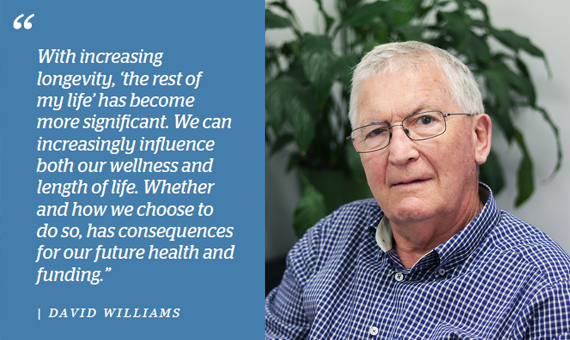The most important journey we have
is the ‘rest of our life’. To make the
best of it requires good planning. The
best plans have a time frame. They
also show when we expect important
things to occur, why and what we will
do about them. If things change, we
can respond.
Ageing progresses just a
day at a time but there can be sudden
challenges. Without planning, we are
prone to make hasty and inappropriate
decisions
Each of us is different and we tend to
get more different over time. So, we
need our own longevity plan to make
the best of our life and adapt as required.
It underpins our other health, financial, career
and estate plans.
TIME AND LONGEVITY
‘Time’ is the most commonly used
noun in the English language. Most
people understand and speak easily
about time. It makes sense to plan
using time concepts wherever possible.
However, when we come to discuss
‘our time’ – our lifespan – few of us are
well informed. Most of us already know
people are living longer but we don’t
know why and whether it applies to
us. Ignorance can lead to fear, making
us vulnerable to fear-based marketing,
while media comments about old
age, retirement, longevity risk and age
discrimination all add to our anxiety
Yet, we can address this ignorance by
understanding more about longevity
and applying this to create our own
longevity plan. Easy ‘time’ conversations
can enable us to share our thoughts
with others.
WHY HAS COMMUNITY LONGEVITY INCREASED?
So, why are we living longer? Well,
societies generally began to live longer
over the last two centuries
The industrial revolution enabled
communities to develop and fund
infrastructure (such as, sewers, fresh
water, roads and bridges), broaden
and deepen education, and promote
specialist knowledge (as in medicine),
evolve laws and standards, improve
information sharing and so on.
As a result, lifespans in ‘developed’
countries, like Australia, have increased.
Table 1 outlines four time periods.
Not surprisingly, the consequences of
an ageing society, such as increasing
costs and other implications of
this change, are far-reaching. As a
community, we are inadequately
prepared for a wide range of social
issues affecting the funding of age
pensions and superannuation, health
and aged care services, and lifestyle for
older Australians.
This makes it important for us to be
as informed as possible about our
own potential timeframe, allowing us
to better understand the things we
can do to make the most of it and to
integrate this knowledge into our other
planning decisions.
IS COMMUNITY LONGEVITY STILL INCREASING?
Life expectancy has increased on
average by about two years per
decade over the past 200 years and is
currently about 83 years.
However, since 2000, life expectancies
in Australia have declined for people in
their late 80s and beyond. We may be
seeing the end of the ‘easy’ increases.
Increases in obesity in early life may
be one factor: also, as people survive
longer, rising challenges to the brain
and neural systems are difficult to
understand and treat.
This will compound problems for
aged care services and costs, already
increasing and accompanied by quality
challenges. The ethics of prolonging
life is coming under close scrutiny,
with choice of death supported by a
majority of older people.
These are all issues that will influence
the outcomes of personal plans.
BUT WHAT ABOUT ME?
Communities are living longer, but
what about me? There are ‘Life Tables’
that tell us average lifespans for each
age, but the problem is, most people
aren’t average.
The spread of deaths (in five year
groups) from age 65 shows this. At age
65, less than one-quarter of people live
to within three years of the average
age of 86. The rest are short or long of
the average.

So, what about me? Am I likely to live
longer or shorter than average? It’s
a vital question.
There has been a huge rise in long term studies establishing reliable
links between life expectancies and a
large number of behavioural, health,
social and other factors. More clues
come from the survival data of life
insurance companies.
This has enabled the development of
assessments which give better
indications for individuals. For
example, the SHAPE Analyser is
a free online tool that has been
progressively refined since 2008, providing over
180,000 estimates.
We are no longer reliant on average
data. We can reasonably answer
‘what about me’ and understand why
we might be different from others.
This is allowing us to make better
and more informed decisions about
how we respond to our own – and
our clients’ – longevity.
CAN I CHANGE MY LONGEVITY?
Can I really affect my longevity –
the rest of my life? Or is it just a
consequence of evolution?
Well, evolution plays out slowly
and had little part in the doubling
of lifespans over 200 years. The
industrial revolution was the main
change agent. Communities began to
significantly influence the rest of their
life, and so could individuals.
Time plays out differently at different
ages. When we’re young, shorter term
decisions tend to dominate. By midlife,
priorities are changing.
With increasing longevity, ‘the rest of
my life’ has become more significant.
We can increasingly influence both our
wellness and length of life. Whether
and how we choose to do so, has
consequences for our future health and
funding. Our parents are also living
longer, and we and they are often
poorly prepared for this.
IT’S NOT JUST HOW LONG
The SHAPE Analyser provides a
personal time frame. It also provides
insights into what we could do
to improve our wellness. Further
information is available from the
Australian Institute of Health and
Welfare, which quantifies the average
stages of ‘the rest of life’. See Table 2.
For example, at age 65, on average
there are typically 17 years of living
independently and four dependent
years. We can break down the
independent years to ‘able’ and
‘less able’.
It’s important to note:
- the same things that drive increasing longevity also drive how well we live;
- for many, there’s time to remain well, productive and to get organised;
- we become more different from each other with age: personal decisions do matter;
- the longer we live, the longer we’re likely to live – a survival bonus; and
-
the survival bonus adds independent years and less dependency
(defined as ‘needing support for core daily activities’, and not necessarily for frailty or helplessness).
We can now prioritise our health plans
and other important issues. We can
plan better for potential changes to
our longevity.
MORE ABOUT DEPENDENCY
Table 3 shows the average years of
dependency at key ages. Dependency
tends to reduce with increasing age,
which for many people is unexpected.
Women have almost twice as many
dependent years as men.
However, the greater longevity of
women means dependency typically
begins later. Women are often
younger than their male partners,
who die after a shorter dependency
before their partners enter their
longer dependency. Unfortunately,
women also have a higher likelihood
of dementia.
These are important factors for
financial planning, especially for
aged care, guardianship, powers of
attorney and end of life decisions.
LONGEVITY PLAN
We now have a solid basis for developing a realistic
longevity plan that reflects how long
we may live, why and what we will do
about it, including:
- how we will engage with health advice and take preventative action;
- where we expect to live and why;
- who will manage things – and us – when we can’t;
- who gets what, why (and why not), when and how; and
- our aged care preferences, dependency and end of life.
We can now plan for regular reviews and see how these elements relate to our career plans.
BENEFITS OF A LONGEVITY PLAN
There are many benefits
of having a longevity plan. These
include:
- Each plan is unique for each person;
- It provides a lifetime framework that is easily adapted to changes;
- Immediate and longer-term actions are prioritised, reflecting a client’s life stages;
- It builds relationships and commitment with supportive financial planners and other professional advisers;
- It creates productive interactions with family members and others; and
- It provides a high value.
A CONVERSATION THAT BUILDS TRUST
Most financial decisions have a time
basis, such as how long will my
money last. These decisions can
be based on individual data from a
personal longevity plan.
Time underpins our major
decisions as we age. In fact, a ‘time’
conversation can be easier to have
with clients than a financial one, and
it’s the type of conversation that
builds trust.
By empowering clients to have an
informed and stronger commitment
to their life journey via their longevity
plan, financial planners can take
account of a client’s longevity across
all their key decisions, life stages and
reviews. Longevity planning also
integrates easily with the client
value proposition.
So, isn’t it time longevity planning took
its place in holistic personal advice?
This article first appeared in Money and Life, published in March 2020 by the Financial Planning Association.
